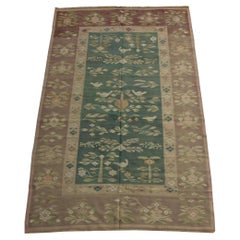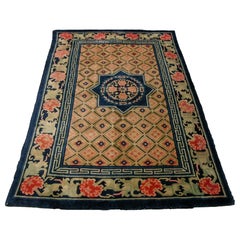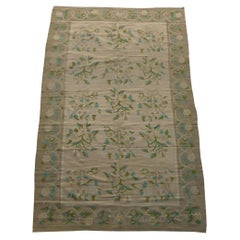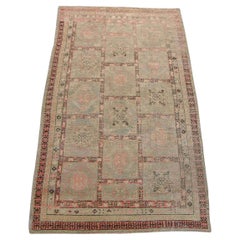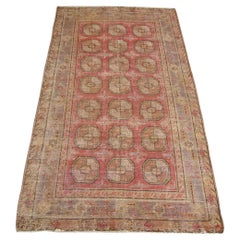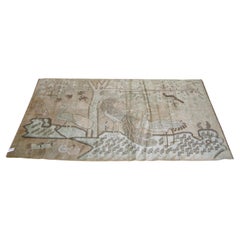Early 1900s Russian and Scandinavian Rugs
to
5
Width
to
Length
to
205
9
2
2
1
8
236
2,177
1,722
438
1,378
141
205
21
61
38
55
126
179
69
5
4
205
202
161
2
203
2
205
205
205
112
25
25
24
23
3
Period: Early 1900s
Early 20th Century Antique Traditional Flat Weave Bessarabian Rug
Located in Los Angeles, US
Antique Bessarabian Rugs / Kilims in both pile and tapestry weaving technique are some of the more beautiful carpets to have been produced in Europe. Many of the Bessarabian Kilims w...
Category
Other Antique Early 1900s Russian and Scandinavian Rugs
Materials
Wool, Cotton
1900s Antique Chinese Small Rug - 7'2'' X 4'5''
Located in Los Angeles, US
Antique Chinese Rugs, as opposed to most of the antique rug productions, were woven almost exclusively for internal consumption. Since they were mostly sheltered from European and We...
Category
Asian Other Antique Early 1900s Russian and Scandinavian Rugs
Materials
Wool
Early 20th Century Antique Kilim Floral Design Rug
Located in Los Angeles, US
Ca. 1900 Antique Kilim Floral Design Rug
Category
Other Antique Early 1900s Russian and Scandinavian Rugs
Materials
Wool, Cotton
Antique Samarkand Rug 1900 -9'7'' X 5'3''
Located in Los Angeles, US
Antique Uzbek Samarkand Rug 9'7'' X 5'3'', tribal and traditional, antique and vintage, wool on cotton foundation
Category
Uzbek Tribal Antique Early 1900s Russian and Scandinavian Rugs
Materials
Cotton
1900 Antique Uzbek Khotan Samarkand Rug
Located in Los Angeles, US
Antique Samarkand Rugs: The desert oasis of Khotan was an important stop on the Silk Road. The people of Khotan were expert carpet weavers who produced high quality antique rugs and ...
Category
Uzbek Other Antique Early 1900s Russian and Scandinavian Rugs
Materials
Wool, Cotton
Antique Samarkand Rug with Animal Print Design
Located in Los Angeles, US
Antique Samarkand Rugs: The desert oasis of Khotan was an important stop on the Silk Road. The people of Khotan were expert carpet weavers who produced high quality antique rugs and ...
Category
Asian Other Antique Early 1900s Russian and Scandinavian Rugs
Materials
Wool, Cotton
19th Century Antique Needlework Floral Rug
Located in Los Angeles, US
Needlepoint rugs were created using the traditional needlework weaving technique that is used to make everyday items from furniture to carpets and artwork. However, it has a fascinat...
Category
Other Antique Early 1900s Russian and Scandinavian Rugs
Materials
Wool, Cotton
Antique Collectible Woolen Needlework
Located in Los Angeles, US
Needlepoint rugs were created using the traditional needlework weaving technique that is used to make everyday items from furniture to carpets and artwork. However, it has a fascinating history both as a hobby and as an industry. When many people think of carpets, they think of pile carpets or flat weave kilims, but needlepoint has also been used to create beautiful carpets. These carpets are durable and an important part of carpet history.
Archaeologists and scholars consider the roots of needlepoint to have been around 1500 BC. They consider the first needlepoint to include the fine diagonal stitches that were used to sew tents together by the ancient Egyptians. The art eventually evolved into tapestry weaving. However, a tapestry weaving differs significantly from needlepoint in that it uses a loom and vertical warp.
Tapestry weaving is closer to the weaving of kilims and pile rugs than canvas work. However, some still include tapestry weaving in the category of needlepoint because of the fine work that appeared during the late Renaissance. It can have a similar appearance to the untrained eye. Technically, tapestry weaving and needlepoint are not the same, and they do not use the same technique.
The first actual needlepoint rugs and needle-points began to appear in the late Renaissance. Needlepoint is worked by creating stitches on a stiff canvas. The canvas is typically made from jute or linen and is quite durable. Pieces from the Renaissance were used to cover footstools, chairs, pillows, bed headboards, and other furnishings. They were also used as table coverings and wall coverings. You could also find them on many small items such as purses, shoes, and various adornments for clothing.
During the Renaissance, the craft reached a high level of skill, and the designs became incredibly detailed and realistic. They mimicked many of the subjects and styles of famous paintings of the time. They created florals, still life designs, scenes, and geometric tiled pieces. Some of them mimicked the designs found in Persian Carpets.
Needlepoint reached its peak popularity in the 19th century when it was considered a proper occupation for a lady. Needlepoint and embroidery held a similar place in societal status at the time. During this time, the work became finer, with some of the canvas reaching a high level of detail. The level of detail is determined by counting the number of mesh in an inch. During this time petit point by French needlewomen could have a mesh count as high as 45 mesh. This allowed women to create highly intricate designs with incredible levels of detail.
It is possible to find many antique pieces of needlepoint besides rugs. Needlepoint rugs were popular in France and Spain, where the technique was adapted to create highly intricate designs that mimicked the designs in architecture and fashion. They were popular because they were durable, and it could be fashioned into a variety of items. The canvases themselves were durable, and the wool that they used was also strong, which means that many of the pieces were able to withstand daily use. We have many artifacts that have survived from this time period.
Needlepoint rugs are important collectibles because they are different from the pile rugs and kilims that are typically found on the market. Needlepoint carpets are special because they take many hours to create, especially larger works. Needlepoint pieces of any type became popular throughout Europe during the 19th century. It is still a popular hobby today, but perhaps one of the most interesting stories is that of the Portuguese needlewomen of Arraiolos.
The story of these women and their beautiful carpets begins in 1492. Needlepoint was a popular occupation in Spain, which had a large population of Moors and Jews. They were an integral part of Spanish culture. However, in 1492, Queen Isabella of Spain issued a proclamation that gave these ethnic groups the order to pack their bags and board ships headed...
Category
Other Antique Early 1900s Russian and Scandinavian Rugs
Materials
Wool
Mid 18th Century Antique Bessarabian Floral Rug
Located in Los Angeles, US
Antique Bessarabian Rugs / Kilims in both pile and tapestry weaving technique are some of the more beautiful carpets to have been produced in Europe. Many of the Bessarabian Kilims w...
Category
Other Antique Early 1900s Russian and Scandinavian Rugs
Materials
Wool, Cotton
Early 20th Century Antique Jerusalem Rug
Located in Los Angeles, US
Israeli Rugs – Israel is home to a surprisingly large and well-established carpet-weaving community. Area Carpet weavers in Israel had very serious traditions that were cultural, tec...
Category
Asian Other Antique Early 1900s Russian and Scandinavian Rugs
Materials
Wool, Cotton
Early-19th Century Authentic Uzbek Samarkand Rug 4'8'' X 2'9''
Located in Los Angeles, US
Ca.1900 Authentic Samarkand Rug 4'8'' x 2'9'', Tribal and Traditional, Wool on cotton foundation
Category
Asian Other Antique Early 1900s Russian and Scandinavian Rugs
Materials
Wool, Cotton
Antique Central Asian Style Tribal Samarkand Rug
Located in Los Angeles, US
Antique Samarkand Rugs: The desert oasis of Khotan was an important stop on the Silk Road. The people of Khotan were expert carpet weavers who produced high quality antique rugs and ...
Category
Other Antique Early 1900s Russian and Scandinavian Rugs
Materials
Wool, Cotton
1900 Antique Bessarabian Flat Weave Kilim Rug
Located in Los Angeles, US
Beautiful Collection of Romanian Antique Bessarabian Kilims and Rugs
Antique Bessarabian Rugs / Kilims in both pile and tapestry weaving technique are some of the more beautiful carpets to have been produced in Europe. Many of the Bessarabian Kilims were woven around the mid to late 19th century, though some do date back to the 18th century as well. This production that carried into the early twentieth century under late Ottoman Turkish rule in an area corresponding to modern Bulgaria and Romania, they stand right on the cusp of European and Oriental carpet weaving. Many of the designs are floral patterns made in a naturalistic western style utilizing brown or black ground, not unlike certain Karabaghs from the Caucauses. But others, particularly flat weaves, reflect the tradition of Turkish kilims from nearby Anatolia, although in a distinctive Bessarbian palette. In either case they are supremely decorative rugs.
History Of Antique Flat Woven Bessarabian Kilim Rugs from Romania
Bessarabian Kilims and carpets are flat woven rugs that originate in the Russian provinces of the Ukraine and Moldova in the late 1800’s to the early 1900’s. While most carpet experts will classify the flat woven rugs as Bessarabian they will often refer to the knotted pile carpets as Ukrainian.
The Bessarabian carpets differ from antique Persian carpets in many ways. For example, unlike Persian carpets, Bessarabian rugs cannot be classified to a region according to the way the rugs were woven. Their weaves provide indications regarding the area for which they were created rather than for their classification. The markets these antique rugs were designed for could have fallen into different categories such as a rural market or an urban one. But all other attributes were dismissed and all the Romani made area rugs and carpets are referred to as Bessarabian instead.
Antique Romanian Bessarabian kilims are ornate and they come in a variety of designs as well color combinations. It’s not uncommon for some Bessarabian kilims to be more floral while others may feature more geometric patterns. Bessarabian carpets are made on carpet weaving looms similar to the ones used to make the French Aubusson rugs.
These looms are wooden, and the rugs are flat woven / kilims. The best of these rug types were created in the 1700’s. The Russian Imperial Tapestry Factory was where these Romanian rugs were made, and the factory was created by none other than Peter the Great. He established the Russian Imperial Tapestry Factory following his return from England and France. He was inspired to create the factory after being in awe of the splendid Aubusson carpets, Savonnerie rugs, and Axminster carpets he saw while abroad.
The beautiful carpets he admired while in Europe had already caught the eyes of his Russian contemporaries, and importing them was triggering a financial drain for the Russian treasury. For this reason, the Russian Imperial Tapestry Factory was used as a location for copying the French and English carpets Peter the Great and the Russian nobility desired.
Demand for these lavishly luxurious rugs grew, and additional factories were created in villages. This region is from where these rugs got the name Bessarabian. The region is divided between two territories: the Republic of Moldova and Romania. Bessarabian rug weavers were country people who had a country taste. Though they were tasked with replicating the elaborate motifs of the European rugs, they added their own unique country’s flair to their borrowed rug patterns and designs. This more folksy or traditional approach to the European patterns...
Category
Asian Neoclassical Antique Early 1900s Russian and Scandinavian Rugs
Materials
Wool
Antique Bessarabian Floral Rug
Located in Los Angeles, US
Antique Bessarabian Rugs / Kilims in both pile and tapestry weaving technique are some of the more beautiful carpets to have been produced in Europe. Many of the Bessarabian Kilims w...
Category
Other Antique Early 1900s Russian and Scandinavian Rugs
Materials
Wool, Cotton
19th Century Tribal Persian Shirvan Rug
Located in Los Angeles, US
Shirvan rugs – The historic Khanate or administrative district of Shirvan produced many highly decorative antique rugs that have a formality and stylistic complexity that is found in...
Category
Tribal Antique Early 1900s Russian and Scandinavian Rugs
Materials
Wool
Antique Turkmen Salor Part Silk Rug Geometric Design
Located in Los Angeles, US
Salor rug, floor covering handmade by the Salor Turkmen of Turkmenistan. Most consistent in design are the main carpets, with a quartered gul (motif) showing...
Category
Asian Other Antique Early 1900s Russian and Scandinavian Rugs
Materials
Wool, Cotton, Silk
Early-19th Century Antique Uzbek Samarkand Rug-7'5'' X 4'6''
Located in Los Angeles, US
Early-19th Century Antique Uzbek Samarkand Rug from Uzbekistan
Category
Uzbek Empire Antique Early 1900s Russian and Scandinavian Rugs
Materials
Wool, Cotton
1900s Antique Khotan Samarkand Rug
Located in Los Angeles, US
Antique Samarkand Rugs: The desert oasis of Khotan was an important stop on the Silk Road. The people of Khotan were expert carpet weavers who produced high quality antique rugs and ...
Category
Other Antique Early 1900s Russian and Scandinavian Rugs
Materials
Wool, Cotton
Antique 1900 Samarkand Rug
Located in Los Angeles, US
Antique Samarkand Rugs: The desert oasis of Khotan was an important stop on the Silk Road. The people of Khotan were expert carpet weavers who produced high quality antique rugs and ...
Category
Other Antique Early 1900s Russian and Scandinavian Rugs
Materials
Wool, Cotton
Early-19th Century Khotan Samarkand Rug-8'10'' X 4'10''
Located in Los Angeles, US
Up for sale is an Early-19th Century Khotan Samarkand Rug
Category
Asian Tribal Antique Early 1900s Russian and Scandinavian Rugs
Materials
Wool, Cotton
Antique Oushak Rug 8.9x7
Located in Los Angeles, US
Antique Turkish Oushak rugs have been woven in Western Turkey since the beginning of the Ottoman period. Historians attributed to them many of the great masterpieces of early Turkish...
Category
Other Antique Early 1900s Russian and Scandinavian Rugs
Materials
Wool, Cotton
$9,750
Early 20th Century Antique Kilim Floral Design Rug - 12'7'' X 6'9''
Located in Los Angeles, US
Antique Bessarabian Rugs / Kilims in both pile and tapestry weaving technique are some of the more beautiful carpets to have been produced in Europe. Many of the Bessarabian Kilims w...
Category
Asian Other Antique Early 1900s Russian and Scandinavian Rugs
Materials
Wool, Cotton
Antique Shirvan Rug 2'7'' x 3'2''
Located in New York, NY
Shirvan rug, floor covering handmade in the Shirvan region of Azerbaijan in the southeastern Caucasus. With the exception of a group of rugs woven in the vicinity of Baku, most Shirv...
Category
Russian Antique Early 1900s Russian and Scandinavian Rugs
Materials
Wool
$1,440 Sale Price
85% Off
Antique Caucasian Soumak
Located in WEST HOLLYWOOD, CA
Rug Number
27105
Size
8' 11" X 10' 0"
Design
Soumak
Collection
Antique/Vintage
Material
Wool
Texture
Flat Weave
Origin
Russia
Age
Antique/Vintage
Category
Russian Antique Early 1900s Russian and Scandinavian Rugs
Materials
Wool
$8,500
Antique 1920 Samarkand Rug
Located in Los Angeles, US
Antique Samarkand Rugs: The desert oasis of Khotan was an important stop on the Silk Road. The people of Khotan were expert carpet weavers who produced high quality antique rugs and ...
Category
Other Antique Early 1900s Russian and Scandinavian Rugs
Materials
Wool, Cotton
Antique Russian Chichi, circa 1900s
Located in WEST HOLLYWOOD, CA
Rug Number
17218
Size
3' 5" X 6' 2"
Design
Chichi
Collection
Antique/Vintage
Material
Wool
Texture
Pile Weave
Origin
Russia
Age
Antique/Vintage.
Category
Russian Antique Early 1900s Russian and Scandinavian Rugs
Materials
Wool
1900s Antique Uzbek Khotan Samarkand Rug-5'8'' X 4'1''
Located in Los Angeles, US
Up for sale is a 1900s Antique Uzbek Khotan Samarkand Rug 5'8'' x 4'1'', tribal and traditional, wool on cotton
Category
Uzbek Tribal Antique Early 1900s Russian and Scandinavian Rugs
Materials
Wool, Cotton
Antique Caucasian Kazak by Mehraban Rugs
Located in WEST HOLLYWOOD, CA
Our traditional Caucasian Kazak rug is inspired by tribal patterns. Neutral color schemes are well-complemented with the panel all-over design. This rug is a deal for flooring or wal...
Category
Turkish Antique Early 1900s Russian and Scandinavian Rugs
Materials
Wool
1900 Antique Khotan Samarkand Rug- 8'10'' X 5'3''
Located in Los Angeles, US
Ca.1900 Antique Khotan Samarkand Rug 8'10'' X 5'3''
Category
Asian Tribal Antique Early 1900s Russian and Scandinavian Rugs
Materials
Wool, Cotton
1900 Antique Animal Design Bessarabian Flat Weave Rug
Located in Los Angeles, US
Antique Bessarabian Rugs / Kilims in both pile and tapestry weaving technique are some of the more beautiful carpets to have been produced in Europe. Many of the Bessarabian Kilims w...
Category
Other Antique Early 1900s Russian and Scandinavian Rugs
Materials
Wool, Cotton
Rug Designed by Emma Salzman, Finland, Early 1900s
By Emma Salzman
Located in Stockholm, SE
Rug designed by Emma Salzman,
Finland, early 1900's.
Rya technique. Handwoven wool.
Measurements:
H: 349 cm/ 11' 5 7/16"
W. 185 cm/ 6 26/32"
Category
Finnish Scandinavian Modern Antique Early 1900s Russian and Scandinavian Rugs
Materials
Wool
1900s Antique French Needlepoint Rug
Located in Los Angeles, US
Needlepoint rugs were created using the traditional needlework weaving technique that is used to make everyday items from furniture to carpets and artwork. However, it has a fascinating history both as a hobby and as an industry. When many people think of carpets, they think of pile carpets or flat weave kilims, but needlepoint has also been used to create beautiful carpets. These carpets are durable and an important part of carpet history.
Archaeologists and scholars consider the roots of needlepoint to have been around 1500 BC. They consider the first needlepoint to include the fine diagonal stitches that were used to sew tents together by the ancient Egyptians. The art eventually evolved into tapestry weaving. However, a tapestry weaving differs significantly from needlepoint in that it uses a loom and vertical warp.
Tapestry weaving is closer to the weaving of kilims and pile rugs than canvas work. However, some still include tapestry weaving in the category of needlepoint because of the fine work that appeared during the late Renaissance. It can have a similar appearance to the untrained eye. Technically, tapestry weaving and needlepoint are not the same, and they do not use the same technique.
The first actual needlepoint rugs and needle-points began to appear in the late Renaissance. Needlepoint is worked by creating stitches on a stiff canvas. The canvas is typically made from jute or linen and is quite durable. Pieces from the Renaissance were used to cover footstools, chairs, pillows, bed headboards, and other furnishings. They were also used as table coverings and wall coverings. You could also find them on many small items such as purses, shoes, and various adornments for clothing.
During the Renaissance, the craft reached a high level of skill, and the designs became incredibly detailed and realistic. They mimicked many of the subjects and styles of famous paintings of the time. They created florals, still life designs, scenes, and geometric tiled pieces. Some of them mimicked the designs found in Persian Carpets.
Needlepoint reached its peak popularity in the 19th century when it was considered a proper occupation for a lady. Needlepoint and embroidery held a similar place in societal status at the time. During this time, the work became finer, with some of the canvas reaching a high level of detail. The level of detail is determined by counting the number of mesh in an inch. During this time petit point by French needlewomen could have a mesh count as high as 45 mesh. This allowed women to create highly intricate designs with incredible levels of detail.
It is possible to find many antique pieces of needlepoint besides rugs. Needlepoint rugs were popular in France and Spain, where the technique was adapted to create highly intricate designs that mimicked the designs in architecture and fashion. They were popular because they were durable, and it could be fashioned into a variety of items. The canvases themselves were durable, and the wool that they used was also strong, which means that many of the pieces were able to withstand daily use. We have many artifacts that have survived from this time period.
Needlepoint rugs are important collectibles because they are different from the pile rugs and kilims that are typically found on the market. Needlepoint carpets are special because they take many hours to create, especially larger works. Needlepoint pieces of any type became popular throughout Europe during the 19th century. It is still a popular hobby today, but perhaps one of the most interesting stories is that of the Portuguese needlewomen of Arraiolos.
The story of these women and their beautiful carpets begins in 1492. Needlepoint was a popular occupation in Spain, which had a large population of Moors and Jews. They were an integral part of Spanish culture. However, in 1492, Queen Isabella of Spain issued a proclamation that gave these ethnic groups the order to pack their bags and board ships headed...
Category
Other Antique Early 1900s Russian and Scandinavian Rugs
Materials
Wool, Cotton
Antique Khotan Samarkand Rug-7'5'' X 4'5''
Located in Los Angeles, US
Up for sale is an antique Samakhand Uzbek rug, circa the 1900s.
Category
Uzbek Tribal Antique Early 1900s Russian and Scandinavian Rugs
Materials
Wool, Cotton
Early 20th Century Antique Kilim Bessarabian Rug 9'5'' X 5'5''
Located in Los Angeles, US
Antique Bessarabian Rugs / Kilims in both pile and tapestry weaving technique are some of the more beautiful carpets to have been produced in Europe. Many of the Bessarabian Kilims were woven around the mid to late 19th century, though some do date back to the 18th century as well. This production that carried into the early twentieth century under late Ottoman Turkish rule in an area corresponding to modern Bulgaria and Romania, they stand right on the cusp of European and Oriental carpet weaving. Many of the designs are floral patterns made in a naturalistic western style utilizing brown or black ground, not unlike certain Karabaghs from the Caucauses. But others, particularly flat weaves, reflect the tradition of Turkish kilims from nearby Anatolia, although in a distinctive Bessarbian palette. In either case they are supremely decorative rugs.
History Of Antique Flat Woven Bessarabian Kilim Rugs from Romania
Bessarabian Kilims and carpets are flat woven rugs that originate in the Russian provinces of the Ukraine and Moldova in the late 1800’s to the early 1900’s. While most carpet experts will classify the flat woven rugs as Bessarabian they will often refer to the knotted pile carpets as Ukrainian.
The Bessarabian carpets differ from antique Persian carpets in many ways. For example, unlike Persian carpets, Bessarabian rugs cannot be classified to a region according to the way the rugs were woven. Their weaves provide indications regarding the area for which they were created rather than for their classification. The markets these antique rugs were designed for could have fallen into different categories such as a rural market or an urban one. But all other attributes were dismissed and all the Romani made area rugs and carpets are referred to as Bessarabian instead.
Antique Romanian Bessarabian kilims are ornate and they come in a variety of designs as well color combinations. It’s not uncommon for some Bessarabian kilims to be more floral while others may feature more geometric patterns. Bessarabian carpets are made on carpet weaving looms similar to the ones used to make the French Aubusson rugs.
These looms are wooden, and the rugs are flat woven / kilims. The best of these rug types were created in the 1700’s. The Russian Imperial Tapestry Factory was where these Romanian rugs were made, and the factory was created by none other than Peter the Great. He established the Russian Imperial Tapestry Factory following his return from England and France. He was inspired to create the factory after being in awe of the splendid Aubusson carpets, Savonnerie rugs, and Axminster carpets he saw while abroad.
The beautiful carpets he admired while in Europe had already caught the eyes of his Russian contemporaries, and importing them was triggering a financial drain for the Russian treasury. For this reason, the Russian Imperial Tapestry Factory was used as a location for copying the French and English carpets Peter the Great and the Russian nobility desired.
Demand for these lavishly luxurious rugs grew, and additional factories were created in villages. This region is from where these rugs got the name Bessarabian. The region is divided between two territories: the Republic of Moldova and Romania. Bessarabian rug weavers were country people who had a country taste. Though they were tasked with replicating the elaborate motifs of the European rugs, they added their own unique country’s flair to their borrowed rug patterns and designs. This more folksy or traditional approach to the European patterns...
Category
Neoclassical Antique Early 1900s Russian and Scandinavian Rugs
Materials
Wool
Antique Chinese Rug with Floral Design
Located in Los Angeles, US
Antique Chinese Rugs, as opposed to most of the antique rug productions, were woven almost exclusively for internal consumption. Since they were mostly sheltered from European and We...
Category
Asian Other Antique Early 1900s Russian and Scandinavian Rugs
Materials
Wool, Cotton
Antique Needlework Floral Rug
Located in Los Angeles, US
Needlepoint rugs were created using the traditional needlework weaving technique that is used to make everyday items from furniture to carpets and artwork. However, it has a fascinat...
Category
Asian Other Antique Early 1900s Russian and Scandinavian Rugs
Materials
Wool, Cotton
1900s Antique Animal Samarkand Rug
Located in Los Angeles, US
Antique Samarkand Rugs: The desert oasis of Khotan was an important stop on the Silk Road. The people of Khotan were expert carpet weavers who produced high quality antique rugs and ...
Category
Asian Tribal Antique Early 1900s Russian and Scandinavian Rugs
Materials
Wool, Cotton
Antique Turkish Silk Rug
Located in Los Angeles, US
Turkish rugs (also referred to as Anatolian rugs) are, arguably, the rugs that started it all. These carpets were among the first wave of Oriental antique carpets to be exported into Europe. The vintage Turkish rugs were prized commodities and artistically influential pieces. The designs of Turkish rugs such as the iconic guls, prayer rugs and small repeating patterns found on these carpets, worked their way into the iconic paintings of the European masters, including Memling, Lotto, Bellini, Hans Holbein and many others.
These painters were inspired so much by Turkish rugs and the design motifs they feature that the artists have lent their names to some of these famous Turkish patterns. One of the most famous artists that incorporated rugs from Turkey in his painting was the great and iconic 16th century painter Hans Holbein.
The styles of Turkish rugs...
Category
Asian Other Antique Early 1900s Russian and Scandinavian Rugs
Materials
Wool, Cotton
$25,500
1900s Antique Fine Indian Purple Amritsar Rug
Located in Los Angeles, US
Antique Amritsar Rugs – The spectacular rugs of Amritsar capture the exotic style of India while incorporating a subtle colonial influence. This convergence of eastern and western st...
Category
Asian Other Antique Early 1900s Russian and Scandinavian Rugs
Materials
Wool, Cotton
Antique Needlework Floral Design
Located in Los Angeles, US
Needlepoint rugs were created using the traditional needlework weaving technique that is used to make everyday items from furniture to carpets and artwork. However, it has a fascinat...
Category
Other Antique Early 1900s Russian and Scandinavian Rugs
Materials
Wool, Cotton
19th Century Authentic Khotan Samarkand Rug
Located in Los Angeles, US
Antique Samarkand Rugs: The desert oasis of Khotan was an important stop on the Silk Road. The people of Khotan were expert carpet weavers who produced high quality antique rugs and ...
Category
Empire Antique Early 1900s Russian and Scandinavian Rugs
Materials
Wool, Cotton
Early 20th Century Antique Samarkand Rug
Located in Los Angeles, US
Antique Samarkand Rugs: The desert oasis of Khotan was an important stop on the Silk Road. The people of Khotan were expert carpet weavers who produced high quality antique rugs and ...
Category
Other Antique Early 1900s Russian and Scandinavian Rugs
Materials
Wool, Cotton
19th Century Authentic Samarkand Rug
Located in Los Angeles, US
Antique Samarkand Rugs: The desert oasis of Khotan was an important stop on the Silk Road. The people of Khotan were expert carpet weavers who produced high quality antique rugs and ...
Category
Empire Antique Early 1900s Russian and Scandinavian Rugs
Materials
Wool, Cotton
Antique Central Asian Khotan Samarkand Rug 7'3'' X 4'1''
Located in Los Angeles, US
Antique Central Asian Khotan Samarkand Rug 7'3'' x 4'1''
Category
Asian Other Antique Early 1900s Russian and Scandinavian Rugs
Materials
Wool, Cotton
Mid-19th Century Persian Zanjan Rug 5.6x4.1
Located in Los Angeles, US
Antique Zanjan Rug 5.6x4.1, handmade and hand-knotted, wool on cotton foundation, tribal carpet, authentic Persian carpet, vegetable dyes, tribal carpet from mid-19th Century
Category
Other Antique Early 1900s Russian and Scandinavian Rugs
Materials
Wool, Cotton
Early-19th Century Antique Chinese Small Rug - 5'10'' X 3'3''
Located in Los Angeles, US
Antique Chinese Rugs, as opposed to most of the antique rug productions, were woven almost exclusively for internal consumption. Since they were mostly sheltered from European and We...
Category
Asian Ming Antique Early 1900s Russian and Scandinavian Rugs
Materials
Wool
Antique Khotan Samarkand Rug-7'5'' X 4'5''
Located in Los Angeles, US
Up for sale is an Antique Khotan Samarkand Rug, from Uzbekistan, circa the 1900s.
Category
Uzbek Tribal Antique Early 1900s Russian and Scandinavian Rugs
Materials
Wool, Cotton
19th Century Antique Tribal Khotan Samarkand 8'9'' X 5'8''
Located in Los Angeles, US
Antique Samarkand Rugs: The desert oasis of Khotan was an important stop on the Silk Road. The people of Khotan were expert carpet weavers who produced high quality antique rugs and ...
Category
Asian Tribal Antique Early 1900s Russian and Scandinavian Rugs
Materials
Wool, Cotton
Antique Khotan Samarkand Rug-8'0'' X 5'5''
Located in Los Angeles, US
Up for sale is a 1900s Antique Decorative Khotan Samarkand Rug
Category
Asian Tribal Antique Early 1900s Russian and Scandinavian Rugs
Materials
Wool, Cotton
Antique Handmade Samarkand Rug Ca.1900 - 8'7'' X 5'4''
Located in Los Angeles, US
Antique Samarkand Rugs: The desert oasis of Khotan was an important stop on the Silk Road. The people of Khotan were expert carpet weavers who produced high quality antique rugs and ...
Category
Asian Tribal Antique Early 1900s Russian and Scandinavian Rugs
Materials
Wool, Cotton
19th Century Khotan Samarkand Rug
Located in Los Angeles, US
The desert oasis of Khotan was an important stop on the Silk Road. The people of Khotan were expert carpet weavers who produced high quality antique rugs and carpets for both interna...
Category
Empire Antique Early 1900s Russian and Scandinavian Rugs
Materials
Wool, Cotton
1900s Antique Uzbek Khotan Samarkand Rug-8'10'' X 5'6''
Located in Los Angeles, US
Antique Uzbek Khotan Samarkand Rug 8'10'' X 5'6'', tribal and traditional, antique and vintage, wool on cotton foundation
Category
Uzbek Tribal Antique Early 1900s Russian and Scandinavian Rugs
Materials
Wool, Cotton
Ca.1900 Authentic Khotan Samarkand Rug 8'10'' X 5'6''
Located in Los Angeles, US
Ca.1900 Authentic Khotan Samarkand Rug 8'10'' X 5'6''
Category
Asian Tribal Antique Early 1900s Russian and Scandinavian Rugs
Materials
Wool, Cotton
Antique Baluch Turkman Rug 1' 6" x 3' 2"
Located in New York, NY
Antique Baluch Turkman rug, Size: 1'6" x3'2".
Category
Russian Antique Early 1900s Russian and Scandinavian Rugs
Materials
Wool
1900s Antique Indian Amritsar Rug
Located in Los Angeles, US
Antique Amritsar Rugs:
-
The spectacular rugs of Amritsar capture the exotic style of India while incorporating a subtle colonial influence. This convergence of eastern and western s...
Category
Asian Other Antique Early 1900s Russian and Scandinavian Rugs
Materials
Wool, Cotton
Antique Saruk Rug 5.1x3.5
Located in Los Angeles, US
Sarouk Rugs– The thickness of the luxurious pile allows Sarouk rugs to withstand the level of foot traffic that would be typical in hallways, common rooms and foyers. The style, qual...
Category
Other Antique Early 1900s Russian and Scandinavian Rugs
Materials
Wool, Cotton
1990s Savonnerie Area Rug-10'0" X 8'0"
Located in Los Angeles, US
21th Century Authentic Savonnerie Area Rug 10'0" X 8'0", handmade and hand-knotted, wool on cotton foundation, reproduction
Category
Asian Empire Antique Early 1900s Russian and Scandinavian Rugs
Materials
Wool, Cotton
Antique Russian Khotan Rug with Beige and Brown Diamond Medallions
Located in Dallas, TX
Antique Russian rug handwoven from the finest sheep’s wool and colored with all-natural vegetable dyes that are safe for humans and pets. It’s woven using Khotan design featuring a m...
Category
Russian Khotan Antique Early 1900s Russian and Scandinavian Rugs
Materials
Wool
$16,000 Sale Price
20% Off
Early 20th Century Antique Shahsavand Fish Design Flat Weave Rug
Located in Los Angeles, US
Shahsavan Rugs – Highly unusual and exciting, antique Shahsavan or Shahsevan area rugs and carpets have only recently been recognized as a distinct style of Persian rug. Uniquely, Sh...
Category
Asian Other Antique Early 1900s Russian and Scandinavian Rugs
Materials
Wool, Cotton
Antique Oushak Rug 10.8x9.2
Located in Los Angeles, US
Antique Turkish Oushak rugs have been woven in Western Turkey since the beginning of the Ottoman period. Historians attributed to them many of the great masterpieces of early Turkish...
Category
Other Antique Early 1900s Russian and Scandinavian Rugs
Materials
Wool, Cotton
Recently Viewed
View AllMore Ways To Browse
Antique Glass Tobacco Jar
Antique Italian Painted Dresser
Antique Mail Cabinet
Antique Marble Wash Stand
Antique Metal Match Holder
Antique Milk Creamers
Antique Oyster Majolica Plates
Antique Pairpoint Glass
Antique Pedestal Fruit Bowl
Antique Pie Birds
Antique Piggy Bank
Antique Primitive Blanket Chest
Antique Punch Tool
Antique Tang Dynasty Horse Sculpture
Antique Tea Leaf China
Antique Wall Pocket Vase
Antique Wall Pocket Vases
Antique Wedgwood China
